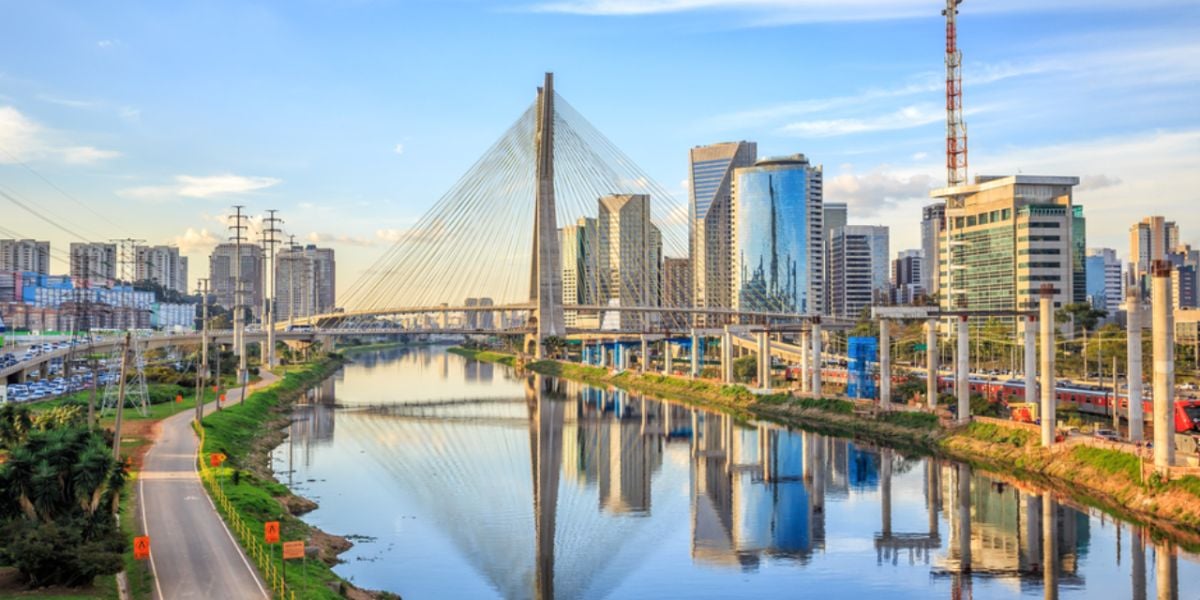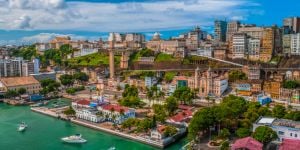
São Paulo is Brazil's largest city by far. It offers a wide variety of accommodations with different levels of comfort and for all budgets. If you're making a short stay in the region, you could stay in a hotel or a serviced residence flat. Otherwise, you could opt for an apartment or perhaps a shared house. Before beginning your search for accommodation in São Paulo, first read Expat.com's Accommodation in Brazil section.
Living in São Paulo
São Paulo is the financial heart of not just Brazil, but all of South America. As such, it attracts Brazilians and foreigners seeking high-paying jobs. São Paulo is not a cheap city by any means. Dining out and entertainment come with high price tags. While rent prices were actually lower in São Paulo than in Rio de Janeiro, as there was a greater supply of units, that's no longer the case today. Rent is slightly more expensive in São Paulo now, but not by too much.
São Paulo, with a population of 12 million and a metro population of almost double that, covers an enormous area, and its traffic jams are the stuff of legends here in Brazil. Accordingly, give careful consideration to where you live. In particular, try to live as close as possible to your job if you expect to be driving. Commutes can be alleviated somewhat by using São Paulo's public transport system, which is efficient and includes multiple metro lines that integrate with buses to cover almost all of the city.
São Paulo is also well-connected to the rest of Brazil. The metropolitan area is serviced by three airports: Guarulhos, Congonhas, and also Virapocos (in nearby Campinas). Accordingly, it's easy to explore Brazil if you live in São Paulo.
Neighborhoods in São Paulo
São Paulo is divided into 31 districts, which are grouped in nine areas. The city center consists of modern high-rise office buildings, while the southern district hosts a growing number of international and multinational companies.
In general, the western and southern parts of São Paulo are the best in which to live. Some parts of the downtown area are also good, though some are less safe at night, so consult a local if you're considering this area. The northern and eastern parts of the city are less desirable.
If you consider the downtown area to be the center of a clock face, then many of the more desirable bairros (city districts) lie from the 6 (surrounding the sprawling Ibirapuera Park) around to the 9. Bairros included in this swath include Paraíso, Vila Madalena, Moema, Vila Nova Conceição, Vila Olímpia, Itaim Bibi, Jardins, Pinheiros, and Vila Magdalena. Higienopolis and Baixo Augusta, closer to the downtown, are also popular. To a degree, each of these bairros is self-contained, with its own shops, banks, etc. Each also has its personality; Baixo Augusta, for example, has a vibrant nightlife, while Moema, near Ibirapuera Park, is a quieter area.
To find out more about the more popular neighborhoods, keep reading below.
Brooklin Novo
Younger expats enjoy the neighborhood of Brooklin Novo, especially since it's more authentic than other neighborhoods that are more saturated with expats. It's mostly residential and there are small shops rather than big chains here.
If you've got pets, then they'll enjoy it here. There lots of parks and green spaces in Brooklin Novo.
Santa Cecilia
Santa Cecilia is a fantastic neighborhood for young and single expats who are on a tighter budget. It's very close to the center of São Paulo and has old historic charm. Many younger expats who teach English and do volunteer work flock to this neighborhood.
Do note that the cheaper rent prices here come with some caveats. There's lots of pollution and noise. However, there are also many bars and restaurants, so this more than makes up for the downsides.
Vila Madelena
The neighborhood of Santa Cecilia is considered bohemian to some people. But for a real bohemian experience, you'll want to live in Vila Madelena.
There are lots of young expats and international students here, which has caused the proliferation of many quality bars and clubs. So if you're moving your family here, it may not be ideal, since the neighborhood is quite lively and noisy, especially on the weekends.
If you're planning on driving, Vila Madelena isn't great for transport. Traffic gets very bad in these parts, so you should take public transport instead.
Chácara Flora
Chácara Flora is one of the best neighborhoods to move your family to in São Paulo. Not only this neighborhood belong to the largest suburb of Santo Amaro, but it also has plenty of good and secure housing. Not only are there lots of green spaces, but there are also numerous international schools you can send your kids to.
Within the area, you'll have access to excellent restaurants, supermarkets, and other shopping options. Like in most other parts of São Paulo, public transport is great. And Chácara Flora is close to the Congonhas Airport, which is fantastic if you and your family fly often.
Morumbi
Morumbi is similar to Chácara Flora in that lots of expat families are drawn to it. It has lots of green spaces, and pollution's not as noticeable in this neighborhood. And like Chácara Flora, there are many international schools here too.
You and your loved ones will have many shops and cafes to visit and pass the time in. Morumbi's also in close proximity to one of the city's best hospitals, Albert Einstein Hospital. So you can have peace of mind knowing you'll get the best treatment possible, and quickly as well, should anything happen.
Alphaville
Do you prefer to live away from all the action? Then perhaps Alphaville is right for you. This neighborhood is located 12 miles outside of central São Paulo and has a small-town feel. You'll get more value for money here, as it's possible to rent large properties that sometimes even come with swimming pools and big yards.
Alphaville is also very safe and isolated, offering your family a nice and quiet place to grow in. However, it can be challenging to get around. So for those who need to travel often for work or leisure, it can be frustrating. Uncharacteristically of São Paulo, Alphaville doesn't have good public transport links. And while you can drive, this can also be difficult since you'd need to go on the highway, which can get heavily congested.
Accommodation prices in São Paulo
You can find furnished one-bedroom apartments in most of the bairros noted above for R$2,300 to R$2,700 (Brazilian reals), not including condominium fees and taxes. Nicer areas will run more, but unfurnished apartments can be found for less. A standard three-bedroom apartment will cost around R$3,800 to R$5,500 per month, plus condominium and taxes. Houses are less common in the city than are apartment blocks, but detached and semi-detached homes can be found. Rent prices will vary widely, from less than R$3,000 to more than R$10,000, plus taxes and any condominium fees.
There are also many residence flats (aparthotels) in São Paulo, generally in good areas near downtown. These properties have numerous advantages. They typically provide various amenities such as a gym, swimming pool, cleaning service, etc. You won't need to qualify for a lease and can pay by credit card. However, these establishments cater largely to business travelers and aren't cheap. It's rare to find a quality one for less than R$5,000 per month, and many can run upwards of R$9,000.
Good to know:
For long-term stays, you'll almost certainly be granted a substantial discount, so don't hesitate to ask.
If you want to buy a residential property in São Paulo, expect to pay about R$7,000 to R$10,000 per square meter, with properties closer to downtown usually costing more.
Apartment shares are an option for those on a budget but wish to live in a nicer area. These arrangements are common in São Paulo. For apartment-sharing, expect to pay anywhere between R$800 and R$2,000 per month. RoomGo is an excellent way to find apartment shares.
For short-term stays, you could stay in a traditional hotel, or rent a room via Airbnb. There are many Airbnb properties in São Paulo. Prices vary widely depending on location, amenities, and the duration of your stay.
The renting process
To get started, visit all the neighborhoods you're interested to get a feel for things. Make sure to go at different times of the day to get an accurate feeling. If you find properties you're interested in renting out, contact the landlord or rental agency to schedule a viewing. Take this time to check everything; even though it's hard to come by an acceptable place to rent, that doesn't necessarily mean you should rush the process.
If you do find the property to be up to your standards, then contact the landlord or rental agency right away. The rental market is hot, and if you don't take the property, chances are, someone else will right away.
The lease
Something you'll notice about renting in São Paulo (and Brazil, in general) is that lease terms are generally 30 months long, or between two and three years. You might understandably not want to sign such a long lease, but sometimes, you have no choice but to do so. However, if you choose a more expat-heavy neighborhood, it's very possible you can get a lease for a shorter term. For example, a landlord might accept 12 months for your lease. In this case, the contract will still be a 30-month one, but they'll add a clause. Essentially, it'll allow you to leave at any point after 12 months without penalty.
When signing the lease, you'll need a few things. For one, you'll need your Brazilian Identity Card (Cadastro de Pessoas Fisicas (CPF)). This can take a few months to get after applying, so you'll need to temporarily stay in short-term accommodations until you receive your CPF. You'll also need either one or two fiadors (co-signers). Not only that, but the fiadors need to meet certain requirements to qualify as such. If you're having trouble finding people to be your fiadors, then another option is to pay a higher deposit. Or you can try showing the landlord or rental agency a strong work history to prove you can be trusted to pay rent on time.
If you're working with a landlord, you can try haggling for a lower rent price. Even some rental agencies will lower the rent at times, so give it a try. You just might be able to shave a little off each month, which adds up.
You'll need to get your rental contract notarized if you're signing it from overseas. Do note that foreign notarizations aren't accepted, so you'll need to get a Brazilian notarization.
The deposit
Anything between one to three months' rent is normal for a deposit. If you don't feel comfortable giving someone this much money, get peace of mind knowing that landlords and agencies are required by law to put that amount in a savings account that's not their own. If you're wondering about any interest earned while your money's in that account, this works in your favor. They must give you the money earned there, regardless of the total they're giving back from your deposit.
If you're renting short-term accommodations, deposits won't apply to your situation. All you'll need to do is pay your rent every month and give them ample warning before you want to move out.
There's another drawback here if you're signing a rental contract from overseas. Because it's riskier for landlords and real estate agencies, they're legally allowed to ask for a down payment equal to 50% of the price you'd pay for the duration of your stay. So if you're signing for 12 months, they can ask for six months' rent upfront. The other legal thing they can ask of you is to have a fiador, so if you can find one, this might be the better option than handing them such a large sum of money.
Useful links:
We do our best to provide accurate and up to date information. However, if you have noticed any inaccuracies in this article, please let us know in the comments section below.








